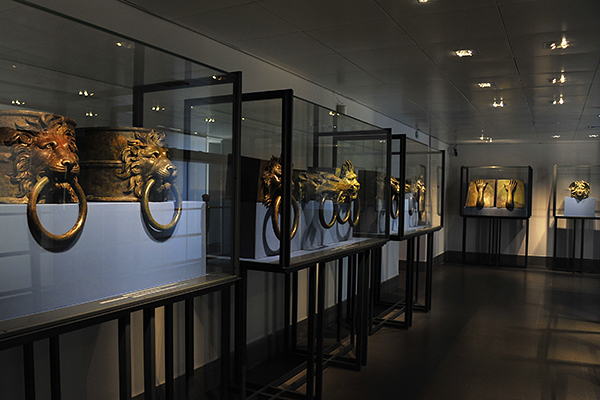
These magnificent cast-bronze fittings (the heads of four wolves, three lions, and one panther) were salvaged from Caligula's pleasure barge, the first ship (prima nave) to have been recovered from Lake Nemi. All are examples of a protome, a decorative element that here was used as the terminal for a wooden beam, and now are in the Palazzo Massimo alle Terme, one of four locations of the National Roman Museum, which acquired them in 1906.
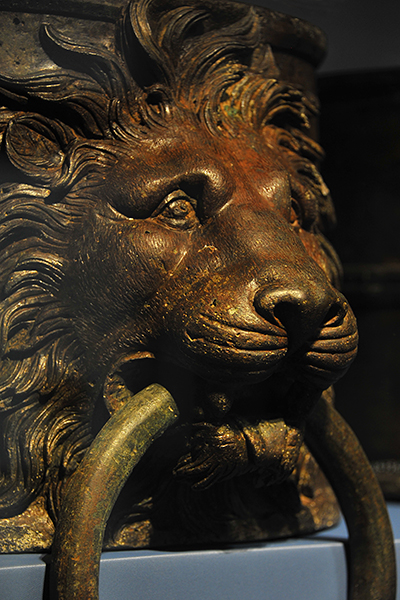
One of the very first pieces to be brought to the surface (by Borghi in 1895), this gilded bronze head of a lion, framed by a thick mane and holding a mooring ring in its mouth, decorated the terminal that capped the port-side steering rudder that hung off the stern quarter of the ship (and so, in a Mediterranean context, called a quarter rudder). Vittorio Malfatti, who wrote the official report of the exploration, considered the figure "remarkable for its beauty."
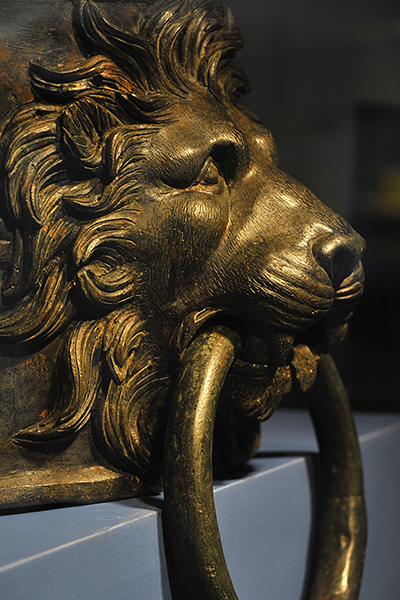
The second lion, recovered by Ucelli in 1929 and still attached to the starboard quarter rudder, verified the function of the earlier one found by Borghi. The single massive timber was almost twelve meters long, about the length of a typical utility pole.
In this reconstruction of the prima nave as it was originally displayed, the boarding stairway next to one of the rudders (which is capped by its leonine protome) is supported by a frame of heavy beams—those running crosswise adorned with the bronze heads of a lion and a panther and the lengthwise beams, with two wolves.
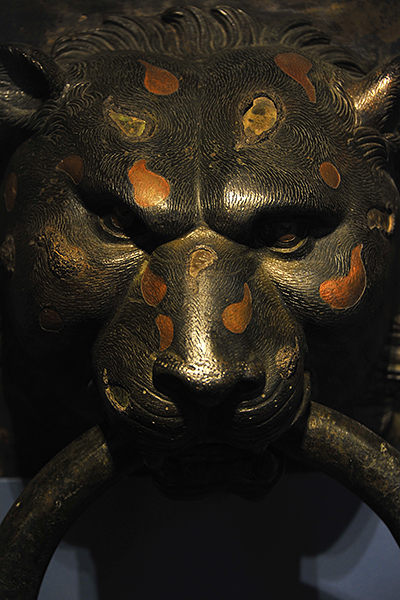
The panther is particularly impressive, its spotted coat rendered by damascening, whereby flame-like sheets of copper and tin (some missing) were set into the bronze surface—recalling the introductory lines to Blake's 1794 poem: "Tyger tyger, burning bright / In the forests of the night." Assuming that the eight bronzes decorated the two projecting stairways, the head of the other panther may have been replaced by a third lion.
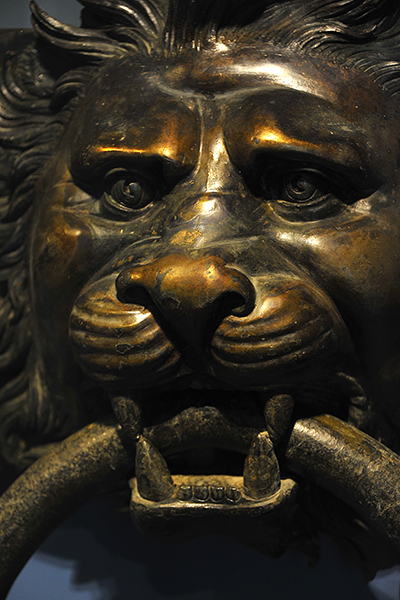
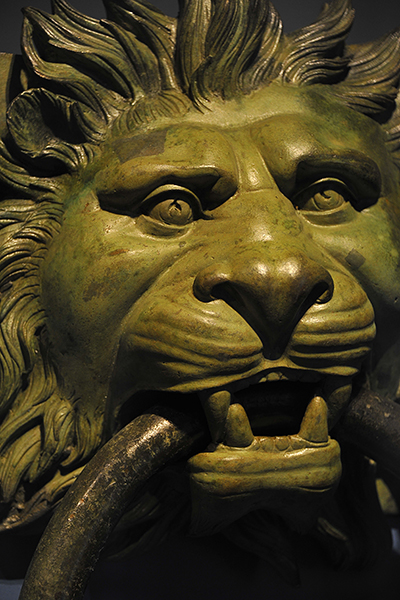
The ring held in the teeth shows no wear and likely served only an ornamental function, perhaps providing a hitch for small boats or used to hang garlands.
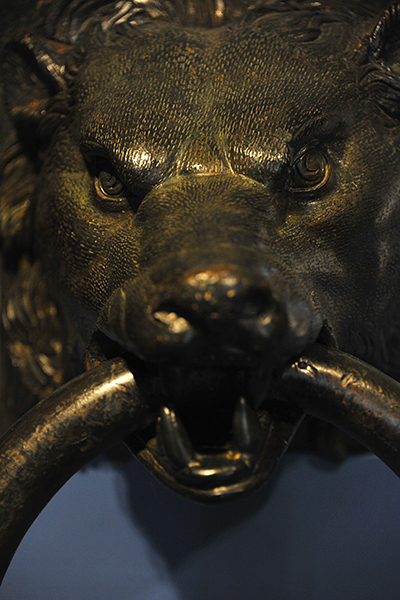
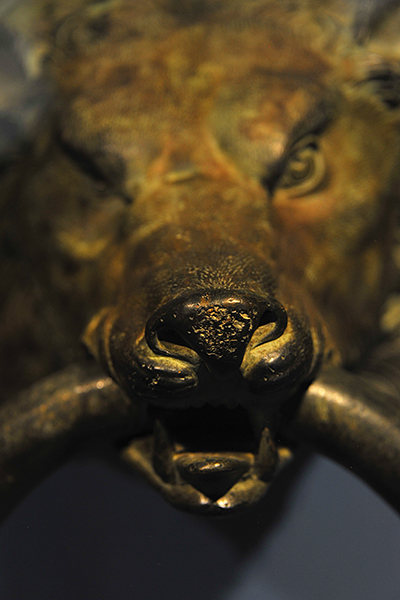
The snarling wolves are fiercer than their leonine counterparts, with bared teeth, fierce eyes, and lowered ears.

A section of the railing from the second ship also survived, with the pillars capped by two-faced herms, paired maenads alternating with pairs of satyrs and Silenuses, all part of the cult of Dionysus.
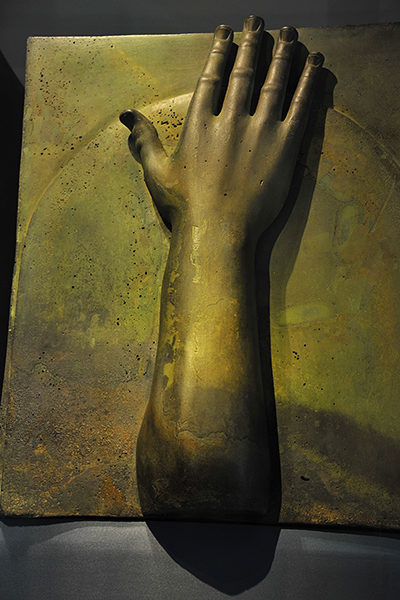
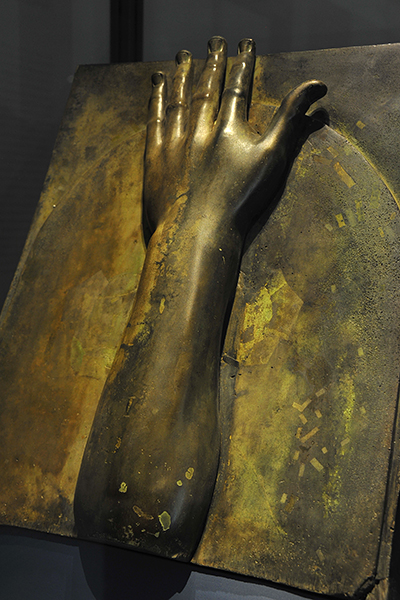
Right and left forearms capped outrigger beams that supported the rudders on each side of the ship. Three such bronzes were found, which suggests that they were two pairs of rudders, mounted at both ends of the hull. These four quarter rudders allowed the ship to maneuver without having to turn around. Rather, rowers simply reversed stroke and pushed rather than pulled their oars. The up-turned thumb and fingers pointing away from the ship serve an apotropaic function in averting evil—just did the head of the gorgon Medusa, the terror of her frightful outward gaze intended to ward off other such terrors, one evil to deter another.
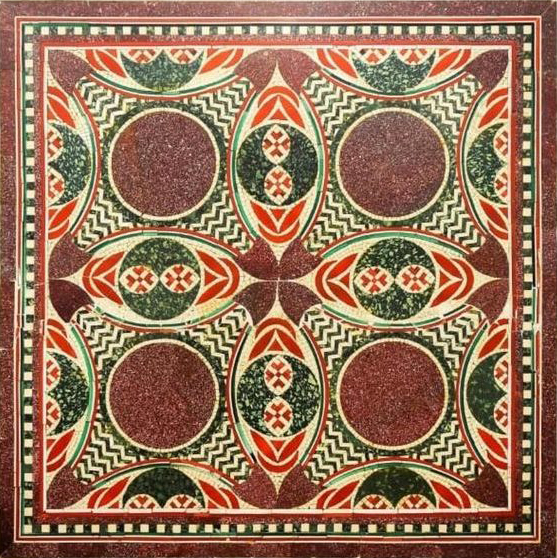
Originally photographed in the 1930s, together with the bronze protomes and other artifacts from the Nemi ships, this magnificent mosaic (a fragment also survives) likely was stolen sometime before 1944, as it shows no damage from the fire that destroyed the Museo delle Navi Romane at the end of May that year. Given a frame and stand, the mosaic of green and red porphyry, serpentine, and molded glass ended up being used as a coffee table in a fashionable Park Avenue apartment, where it was pictured in a 2011 issue of Architectural Digest.
The importance of the five-foot square slab was not realized until 2013 when, at a book signing in New York by Dario Del Bufalo for his book Porphyry: Red Imperial Porphyry, Power and Religion, its photograph was recognized by one of the attendees who, turning to his companion, remarked "Oh, Helen, look, that's your mosaic." Helen Fioratti, an art dealer, later said that she had innocently purchased it from an aristocratic Italian family in the late 1960s. But there was no proof of purchase or provenance and, against a possible charge of possessing stolen property, she was obliged to relinquish the mosaic in 2017, when it was returned to Italian government and, after restoration (mainly to remove the coffee and tea stains), again put on display in the museum in 2021. Having reported the encounter, Del Bufalo promised to make her a replica. The aggrieved art dealer boasted that she could have made a fortune had she ever sold it.
Imperial porphyry, the same deep purple color favored by the rulers of Rome and Byzantium, was a fine grained, crystal flecked, and extremely hard granite mined from a single isolated quarry in the eastern Egyptian desert that had been discovered, as commemorated by a stele found there, by Caius Cominius Leugas on July 23, AD 18 (the fourth year of Tiberius' reign)—but discovered only in 1995. Pliny relates that "Porphyrites, which is another product of Egypt, is of a red colour: the kind that is mottled with white blotches is known as 'leptospsephos,'" which first was brought to Rome as statuary by Vitrasius Pollio, the Egyptian procurator during the reign of Claudius (Natural History, XXXVI.xi.57; earlier, he had been prefect under Caligula). Mined by slaves and transported by oxen, the blocks of stone were shaped by masons and then taken south along the Via Porphyrites, one of several trade routes that connected the Red Sea to an eastward bend in the Nile just below Thebes. Strabo describes the journey as taking six or seven days, with "watering-places, having dug down to a great depth" along the route (Geography, XVII.1.45). These fortified wells (hydreumata) were a day's journey apart, and it was a hundred miles to the Nile, where the stone was shipped downstream to the Mediterranean and then to its final destination. The quarry itself was rediscovered in 1822 by James Burton who returned the next year with John Gardner Wilkinson, who called it Mons Porphyrites, a term that seems not to have occurred in the classical literature and may derive by analogy from the nearby quarry at Mons Claudianus, the gray granite of which was used for the eight monolithic columns that fronted the portico of the Pantheon, each shaft weighing about fifty-five tons.
Given that the Municipal Civil Protection of Nemi recently has begun to inspect and clean the lakebed, more artifacts from the ships may be recovered.
References: "A Remnant from Caligula's Ship, Once a Coffee Table, Heads Home" (2017, October 19) by James C. McKinley, Jr., New York Times; "Via Porphyrites" (1998, November/December) by Louis Werner, Saudi Aramco World, 49(6), 2-9; "The Roman Remains in the Eastern Desert of Egypt" (1952) by David Meredith, The Journal of Egyptian Archaeology, 38, 94-111; "Fieldwork, 1994-5: Memphis, North Saqqara, Amarna, Qasr Ibrim, North Sinai, Eastern Desert, and Mons Porphyrites" (1995) by <Valerie Maxfield>, The Journal of Egyptian Archaeology, 81, 1-21 (this early fieldwork is continued in The Roman Imperial Quarries: Survey and Excavation at Mons Porphyrites 1994-1998, 2 Vols., 2001, 2007; "Porphyrites, The Bradford Village," the Desert Networks Project (DN_SIT2070) online; "A Survey of Place-Names in the Egyptian Eastern Desert during the Principate according to the Ostraca and the Inscriptions" (2018) by Héléne Cuvigny, in The Eastern Desert of Egypt during the Greco-Roman Period: Archaeological Reports, edited by Jean-Pierrre Brun, Thomas Faucher, Bérangère Redon, and Steven Sidebotham.
